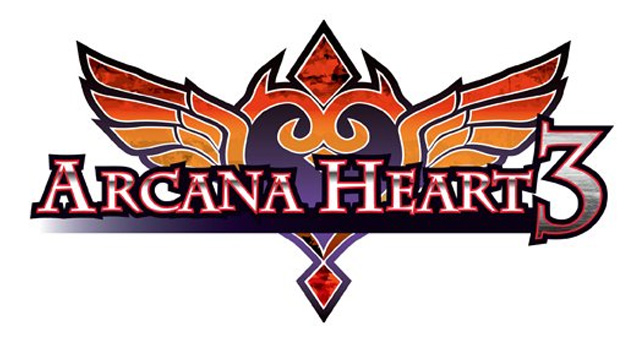
Review: Arcana Heart 3
Posted by Vivas on August 29th, 2011 | 1 Comment | Tags: Arcana Heart 3
When I was handed Arcana Heart 3 to review part of me rejoiced. Another fighting game to test my skills and perhaps apply concepts gained therein to other games in the genre. Unfortunately, what I discovered instead was a strange dichotomy. On the one hand, AH3 is a befuddling and truly insane fighting game with a very high barrier to entry. However, those problems belie a fast-paced, anime fighting game reminiscent of an entry from the BlazBlue franchise. So why this dichotomy?
The main reason for being of two minds about AH3 is its lack of a tutorial. Now in the age of YouTube and streaming internet media, anytime you want to look up combos for a character in a fighting game its as simple as typing words into a search box. Similarly if you want to find a guide for AH3 its as simple as running a Google search which turns up a nifty guide for the game over at Siliconera which explains all of the basics to you straight from the mouth of James Xie, PR coordinator at Aksys Games (the publishing masterminds behind AH3). But if this basic information is so important, why the hell isn’t it in the game in the form of a tutorial or, at the very least, some contextualized hints? Should I give the game a pass for not having a tutorial system? Sadly I don’t have an answer and for the life of me can’t figure out a good, justifiable reason why this game shipped with no tutorial mode at all. Certainly there have been fighting games in the past that did not have any kind of tutorial, but at a time where both the depth and novelty of systems within a game have become more complex its inconceivable that this game has no tutorial at all. As a result players new to the Japanese anime fighting game genre will be at a loss as to how to perform anything in the game. This also marks a huge problem from the standpoint of self-improvement as you have no baseline other than button mashing with which to evaluate your competency with the characters.
But before I get too far ahead of myself lets backup a second and talk story. The story mode of AH3 takes place approximately 2 months after AH2, and lets you choose from any one of the 23 characters (all female by the way) to play as as you search for a way to stop the corporation known as the Drexler Institution from destroying Japan in 6 days. Perhaps one of the cooler parts of the story is the fact that you can select your opponent for each round of the story mode. Unlike traditional fighting games there is no preset, randomly chosen ladder of opponents that the game has you fight. With each fight you draw closer to the end of the game and a final confrontation with an entity called Ragnarok.
After choosing a character you can also select one of 23 different arcanas which will provide different boosts to super moves. For example, the arcana known as Love is one of the more defensive arcanas and provides some damage reduction at the cost of damage dealing. Meanwhile, an arcana like Sin provides more offensive capabilities rather than defensive. In the end, you get a lot of freedom to customize between character attack range, speed, and arcanas. Given this high level of customization, AH3 also features a relatively forgiving combo meter that takes into account the variance between character speeds. In fact, there’s even a trophy for performing a 666-hit combo that is aptly named “Sympathy for the Devil”.
The fighting in AH3 feels pretty fast and responsive, but there are times where you feel like you should be dealing more damage than you actually are, or you’re absorbing more damage than you should. Intuitively you would think that mashing out strong attacks instead of weak ones would mean a higher amount of damage dealing, but this is not always the case. Adding to further frustrations regarding the lack of tutorials are the slew of different gameplay mechanics at work. As an example, AH3 has moments called Intercepts, where both players are striking at the same time. During these moments the players are parrying each other’s attacks and deal no damage to each other. Its an interesting idea that adds a level of complexity when the chips are down and your opponent isn’t blocking but is parrying your attacks. There’s also a system in place to prevent infinites by allowing a player to simply press R2 to send an opponent to the opposite edge of the screen. Homing attacks can be performed to get you closer to your opponent to keep a juggle going, and are particularly useful when a fight gets very vertical with high flying jumps and super moves that send opponents into the air.
As for the multiplayer aspects, AH3 plays pretty well online. Game sessions between Chris and myself didn’t have much lag at all and connecting to another player’s lobby makes use of the standard invitation system through PSN. The only complaint I have about the online is that post match the game always asks if you would like to record a replay which can get annoying and made me wish there was some option I could toggle to turn it off. Also starting a new match with an opponent can take some time as the game has to change your record right then and there. So don’t be alarmed if you can’t start a new match right away as the game takes some time to think about how to add 1 to your win or loss column. I suppose that I shouldn’t be surprised by this oddity given some of the other awkward design choices that are present in AH3.
From a sound design standpoint, AH3 has some crazy Japanese VO and does not give you the option to change the audio to English. To its credit, this adds a really cool layer of authenticity that is missing from some games of Japanese origin. Unfortunately, my Japanese is pretty rusty so thank god for English captions and text. Graphically, the game looks fluid and crisp as characters each have a unique look and feel. The moves and animations are appropriately flashy and fit the anime art style well.
In order to sum up my frustrations (and this already long-winded review!) let me close by offering a (hopefully!) simple example. Suppose you build a Lego pirate or space ship and read the instructions carefully as you build. If you’re really into the act of building the Lego ship you find that you can begin to predict where the next blocks should go in order to make the ship look like it does on the box. After completing it, and wallowing in a well deserved bit of self-worth, you put it on your shelf (or play with it a bit). Eventually a force of destruction in the form of a brother or sister or act of god comes along and destroys the ship. You’re bummed, because you don’t have the instructions, but suddenly find that everything is programmed into muscle memory and, lo and behold, you reconstruct the whole thing with no instructions and prove you’ve mastered its construction. In a similar fashion, video games, specific to this review fighting games, are the same. But notice that in order to accomplish and achieve this level of mastery you have to have some starting point eg: the instructions. Without a tutorial Arcana Heart 3 is tough to recommend, but this decision is even more frustrating given that the game is pretty good. If you want to get past the game’s high barrier to entry you’re going to have to bite the bullet and invest some time in basic training afforded by external sources.
Guide Source: Siliconera (the guide is actually in multiple parts)
A copy of this game was provided by the publisher for review purposes. For more info on our review policy click here. This review is for the PlayStation 3 version of the game.
General Info
- Developer: Arc System Works
- Publisher: Aksys Games
- Release Date: April 2011
- Players: 1-2 (Local), 1-2 (Online)
- Ratings: Teen
Score:
What I Like:
- Deep fighting game mechanics are at work here.
- Anime artstyle is over-the-top.
- Online is quick with very little lag.
- Lots of unlocks associated with the Story Mode.
- It will take even expert players time to master it.
- Diverse list of characters and arcanas can accommodate different play styles and customization.
- Can select your next opponent in the story mode instead of fighting a preset ladder.
What I Dislike:
- No tutorial mode leaves beginners or novices high and dry.
- The depth of the game play mechanics is overwhelming and downright confounding a times.
- High barrier to entry.
- If you need help you have to go to external sources for it.
- Starting a new match in online takes longer than it should.
- The online lacks any real flair and seems to be pretty box-standard.
- The game's offerings are spartan in the sense that the only two modes of interest will probably be Story and Online.
- The story is pretty shallow even by fighting game standards.




